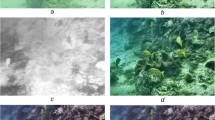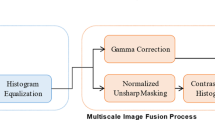Abstract
Underwater images generally experience the ill effects of color shift, haze and contrast deterioration because of scattering and absorption of light in water. There are several techniques that can increase the contrast of an image but most of the techniques lose the originality of the image while increasing the contrast, making these techniques highly inefficient and undesirable. The main goal of the proposed work is to increase the contrast of an image along with the haze removal while keeping the original color intact. A two-step decolorization process is employed for the contrast boosting of the grayscale image, which is later used for reproducing the enhanced color image. Mean and standard deviation-based contrast mapping is used to increase the global contrast and Laplacian pyramids are used for enhancing the local contrast adaptively by identifying the edges in an image. Finally, by combining both the local and global approach a contrast boosted image is produced and the color image is retrieved by changing the L component in CIE Lab color space.










Similar content being viewed by others
References
Akkaynak D, Treibitz T (2019) Sea-thru: A method for removing water from underwater images. In: Proceedings of the IEEE Conference on Computer Vision and Pattern Recognition
Ancuti CO, Ancuti C (2013) Single image dehazing by multi-scale fusion. IEEE Trans Image Process 22(8):3271–3282
Cheng CY, Sung CC, Chang HH (2015) Underwater image restoration by red-dark channel prior and point spread function deconvolution", 2015 IEEE international conference on signal and image processing applications (ICSIPA), pp. 110–115
Chiang JY, Chen YC (2012) Underwater image enhancement by wavelength compensation and dehazing. IEEE Trans Image Process 21(4):1756–1769
Chow LS, Rajagopal H (2017) Modified-BRISQUE as no reference image quality assessment for structural MR images. Magn Reson Imaging 43:74–87
Drews P, Nascimento E, Moraes F, Botelho S, Campos M (2013) Transmission estimation in underwater single images. In Proceedings of the IEEE International Conference on Computer Vision Workshops (pp. 825-830)
Emberton S, Chittka L, Cavallaro A, Wang M (2016) Sensor capability and atmospheric correction in ocean color remote sensing. Remote Sens 8(1):1
Emberton S, Chittka L, Cavallaro A (2018) Underwater image and video dehazing with pure haze region segmentation. Comput Vis Image Underst 168:145–156
Fattal R (2008) Single image dehazing. ACM Trans Graph (TOG) 27(3):72
Fu X, Zhang P, Huang Y et al. (2014) A retinex-based enhancing approach for single underwater image, In Proc. of IEEE Int. Conf. Image Process. (ICIP), pp. 4572–4576
Guo Y, Li H, Zhuang P (2019) Underwater image enhancement using a multiscale dense generative adversarial network. IEEE J Ocean Eng:1–9
He K, Sun J, Tang X (2011) Single image haze removal using dark channel prior. IEEE Trans Pattern Anal Mach Intell 33(12):2341–2353
Jaffe JS (1990) Computer modeling and the design of optimal underwater imaging systems. IEEE J Ocean Eng 15(2):101–111
Kandhway P, Bhandari AK (2019) An optimal adaptive thresholding based sub-histogram equalization for brightness preserving image contrast enhancement. Multidim Syst Sign Process 30(4):1859–1894
Kansal S, Tripathi RK (2019) Adaptive gamma correction for contrast enhancement of remote sensing images. Multimedia Tools Appl 78(18):25241–25258
Keith J (1997) YCbCr to RGB considerations. Tech Rep Intersil
Kuang X, Sui X, Liu Y, Chen Q, Gu G (2019) Single infrared image enhancement using a deep convolutional neural network. Neurocomputing 332:119–128
Li Z, Tan P, Tan RT, Zou D, Zhiying Zhou S, Cheong LF (2015) Simultaneous video defogging and stereo reconstruction. In Proceedings of the IEEE Conference on Computer Vision and Pattern Recognition (pp. 4988-4997)
Li C, Guo J, Chen S, et al. (2016) Underwater image restoration based on minimum information loss principle and optical properties of underwater imaging, In Proc. of IEEE Int. Conf. Image Process. (ICIP), pp. 1993-1997
Li C, Guo J, Cong R et al (2016) Underwater image enhancement by dehazing with minimum information loss and histogram distribution prior. IEEE Trans Image Process 25(12):5664–5677
Li Y, Zhang H, Jiab W, Yuana D, Chenga F, Jia R, Li L, Sun M (2016) Saliency guided naturalness enhancement in color images. Optik Int J Light Electron Opt 127(3):1326–1334
Li J, Sinner K, Eustice R et al (2018) WaterGAN: unsupervised generative network to enable real-time color correction of monocular underwater images. IEEE Robot Autom Lett 3(1):387–394
Li C, Guo J, Guo C (2018) Emerging from water: underwater image color correction based on weakly supervised colro transfer. IEEE Signal Process Lett 25(3):323–327
Li C, Guo C, Ren W, Cong R, Hou J, Kwong S, Tao D (2019) An underwater image enhancement benchmark dataset and beyond. arXiv preprint arXiv:1901.05495
Luczyński T, Pfingsthorn M, Birk A (2017) The pinax-model for accurate and efficient refraction correction of underwater cameras in flat-pane housings. Ocean Eng 133:9–22
Mahmood A, Khan SA, Hussain S, Almaghayreh EM (2019) An adaptive image contrast enhancement technique for low-contrast images. IEEE Access 7:161584–161593
Mittal A, Moorthy AK, Bovik AC (2011) Blind/referenceless image spatial quality evaluator. In Signals, Systems and Computers (ASILOMAR), 2011 Conference Record of the Forty Fifth Asilomar Conference on (pp. 723-727). IEEE
Mittal A, Moorthy AK, Bovik AC (2012) No-reference image quality assessment in the spatial domain. IEEE Trans Image Process 21(12):4695–4708
Nafchi HZ, Shahkolaei A, Hedjam R, Cheriet M (2017) CorrC2G: color to gray conversion by correlation. IEEE Signal Process Lett 24(11):1651–1655
Palanisamy G, Ponnusamy P, Gopi VP (2019) An improved luminosity and contrast enhancement framework for feature preservation in color fundus images. SIViP 13(4):719–726
Paris S, Hasinoff SW, Kautz J (2015) Local Laplacian filters: edge-aware image processing with a Laplacian pyramid. Commun ACM 58(3):81–91
Peng Y, Cosman P (2017) Underwater image restoration based on image blurriness and light absorption. IEEE Trans Image Process 26(4):1579–1594
Peng Y, Cao T, Cosman P (2018) Generalization of the dark channel prior for single image restoration. IEEE Trans Image Process 27(6):2856–2868
Pisano ED, Zong S, Hemminger BM, DeLuca M, Johnston RE, Muller K, Braeuning MP, Pizer SM (1998) Contrast limited adaptive histogram equalization image processing to improve the detection of simulated spiculations in dense mammograms. J Digit Imaging 11(4):193–200
Schechner YY, Karpel N (2005) Recovery of underwater visibility and structure by polarization analysis. IEEE J Ocean Eng 30(3):570–587
Schettini R, Corchs S (2010) Underwater image processing: state of the art of restoration and image enhancement methods. EURASIP J Adv Signal Process 2010(1):746052
Sheinin M, Schechner YY. (2016) The next best underwater view. Proceedings of the IEEE conference on computer vision and pattern recognition
Smith, K., Landes, P. E., Thollot, J., & Myszkowski, K. (2008). Apparent grayscale: a simple and fast conversion to perceptually accurate images and video. In Computer graphics forum (Vol. 27, no. 2, pp. 193-200). Oxford: Blackwell Publishing Ltd.
Sonali, Sahu S, Singh AK, Ghrera SP, Elhoseny M (2018) An approach for de-noising and contrast enhancement of retinal fundus image using CLAHE. Opt Laser Technol 110:87–98
Tian Q-C, Cohen LD (2018) A variational-based fusion model for non-uniform illumination image enhancement via contrast optimization and color correction. Signal Process 153:210–220
Vishwakarma VP, Goel T (2019) An efficient hybrid DWT-fuzzy filter in DCT domain-based illumination normalization for face recognition. Multimedia Tools Appl. 78(11):15213–15233
Yamashita A, Fujii M, Kaneko T (2007) Color registration of underwater images for underwater sensing with consideration of light attenuation. Proceedings 2007 IEEE international conference on robotics and automation, pp. 4570–4575
Zhu Y, Par T, Isola P et al. Unpaired image-to-image translation using cycle-coinsistent adversarial networks. In Proc. of IEEE Int. Conf. Comput. Vis.(ICCV), 2017, pp. 2242–2251
Acknowledgements
Authors N. Jayanthi, Vishal Rajput and S. Indu declare that they do not have any conflict of interest.
Author information
Authors and Affiliations
Corresponding author
Additional information
Publisher’s note
Springer Nature remains neutral with regard to jurisdictional claims in published maps and institutional affiliations.
Rights and permissions
About this article
Cite this article
Jayanthi, N., Rajput, V. & Indu, S. Underwater haze removal using contrast boosted grayscale image. Multimed Tools Appl 79, 31007–31026 (2020). https://doi.org/10.1007/s11042-020-09429-w
Received:
Revised:
Accepted:
Published:
Issue Date:
DOI: https://doi.org/10.1007/s11042-020-09429-w




